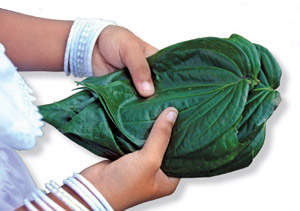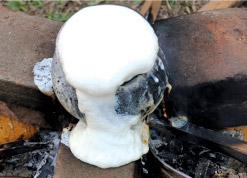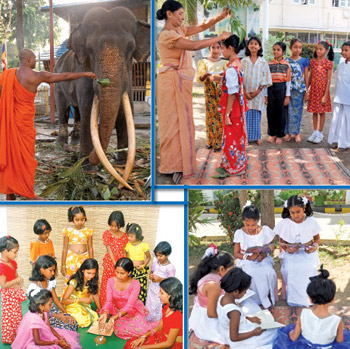|
Sinhala and Hindu New Year:
Let's Celebration in
harmony
It is just over three months ago that the entire world ushered in the
New Year,(according to the Gregarian calendar) with much fanfare. Today
we in Sri Lanka and a few other countries in the Asian region such as
India, Myanmar, Thailand, Taiwan, Japan and China are preparing to usher
in yet another new year which is celebrated
 observing
traditional customs and rituals. What is significant about the new year
celebrated in April in our country is that it is common to the two major
ethnic communities in our country. The Sinhalese and the Tamils welcome
the New Year at an auspicious time and observe many common age-old
rituals and customs which last for nearly a week. observing
traditional customs and rituals. What is significant about the new year
celebrated in April in our country is that it is common to the two major
ethnic communities in our country. The Sinhalese and the Tamils welcome
the New Year at an auspicious time and observe many common age-old
rituals and customs which last for nearly a week.
The Sinhala and Hindu New Year which dawns on April 14 this year is
of great significance because it is the first new year we are
celebrating since the dawn of peace, in our Motherland, after nearly
three decades of conflict It is a symbolic new year because it could be
the platform to unite the two communities still healing from the scars
of the suffering, destruction and bloodshed caused due to acts of
terrorism by the LTTE, and the ethnic clashes that occurred from time to
time.

The treasured dove of peace has finally alighted on our beloved
Motherland which has been weeping tears of blood all these years. The
auspicious time to bridge the ethnic divide and put behind us the
traumatic experiences of that dark era has now come.
The new year which would dawn in another three days time should be
looked upon by everyone as the uniting factor and ushered in with hearts
filled with peace, love and brotherhood. Like the koel's melodious call,
let the song of peace echo throughout our land uniting us as one nation.
Many of you must be already in high spirits, preparing for the coming
festival with your parents and family members. The fragrant scent of
erabadu flowers which blossom around this time of the year may not
perfume the air of the heart of cities, which are virtually concrete
jungles, but it certainly would add a refreshing smell to the already
purified air in the environs of villages.
The song of the koel which heralds in the new year is also more
audible in the villages where the age-old traditions of this rich
festival are still kept alive.
If you happen to be a city person with no links to a village to visit
during the coming festival, don't fail to pay attention to any form of
publicity (either in the print or electronic media) that centres around
the rich traditional customs and rituals of the new year.. The festival
speaks volumes for our glorious cultural heritage. In this hi-tech
cyberspace world, most of our traditional customs, rituals, arts and
even our values are dying out.
Even though the hustle and bustle of life in this modern world give
us no space or time to practise many of these traditions, especially
connected with the new year, we could certainly educate ourselves about
them, and hold on to them as best as we could, without letting them go
into oblivion. Celebrate the new year wearing a radiant smile on your
face, a joyous song of love in your heart and an open mind atuned to
peace and harmony.
************
Some traditional 'n' customs
* The entire new year festival is governed by time. No celebrations
start or end outside of the auspicious times given by astrologers. These
auspicious times or nekath as they are known in vernacular (local
langauge) are determined by the astrologers according to the planetary
movements. Auspicious times are part and parcel of some people's lives
especially in the villages. Everything from birth to death is done
according to these nekath.
  The
astrologer or nekath rala as he was known had a place of honour among
village folk. When the new year season dawns, the nekath rala was given
pride of place. The
astrologer or nekath rala as he was known had a place of honour among
village folk. When the new year season dawns, the nekath rala was given
pride of place.
Visiting him laden with the best of produce from one's own fields and
Avurudhu delicacies was a must. Today this may be observed only in some
parts of the country as astrology is widely practised and giving
auspicious times for the new year festival or any other activity is no
longer confined to a nekath rala.
* Preparing the hearth for the new year is also an age-old custom
that is still practised in many villages. Usually it is carried out by
the mother and in the event there are daughters-in-law they too join her
in this chore. What is generally done is, clay mixed with cow-dung is
applied over the hearth which is cleaned of all the ash prior to this.
As more than one hearth is normally used for cooking, once the cow-dung
is applied and the hearths are ready, one new hearth is reserved to cook
the traditional new year meal while the others are used to do the
day-to-day cooking.
In several villages in the North Western Province, the ash from the
hearth is placed in a winnowing fan (kulla) and kept outside the house
until the dawn of the new year.
The ritual of saving the old ash from the hearth is done because of a
belief that a mythical character called the alu bokka will eliminate all
the bad effects and take away evil spirits from the house.
* Visiting in-laws and relatives is a must during the new year. In
older times people used to carry loads of gifts such as fresh produce
from their home gardens and cultivations, paddy from the fields and
other home-made products especially when they visited their in-laws . In
return the visitors too were given many gifts to take back with them.
* A custom which is observed in some parts of the country, especially
in the South is ganu-denu or transactions with the well. As water is
considered sacred, the well which provides the water for the village
folk is also considered sacred and the first transaction is done with
the well. A few coins wrapped in a piece of clean cloth along with a
little kiribath and some flowers is put into the well. Then the first
bucket of water is drawn.
* Anointing the head with oil made using specially prescribed leaves
for that year is another important custom. Did you know that just as
people are anointed with oil during a new year, even elephants kept in
temples or at home are anointed with oil?
* Games - who celebrates the new year without playing various
traditional games? There are certain games that are played specially
during the new year season. Pancha and olinda keliya, pora pol gehima,
raban gehima, gudu panima and onchili padeema or going on gaily
decorated swings are very popular among them.
* Offering a sheaf of betel leaves and worshipping elders as a mark
of respect is traditional and specially observed during the new year. A
typical bulath atha comprises forty leaves but this number is rarely
adhered to, today. There is a special way to offer it and worship. The
sheaf should be given with both hands, with the stems towards the
receiver.
*********
Fast facts
* In Tamil the new year is referred to as Chittirai varushapirappu
and in Sinhala it is called the aluth avurudda .
* When the Sun moves from the Meena Rashiya (House of Pisces) to the
Mesha Rashiya (House of Aries) the new year dawns.

* The nonagathaya is the period between the end of the old year and
the beginning of the new year. All work ceases during this time and
people usually indulge in religious observances during this time.
* Cooking milk rice or kiribath at the auspicious time is a tradition
a majority of people observe todate. In the hill country, especially in
Kandy, a delicacy called the hath maluwa that has seven different
flavours is cooked during the avurudhu season.
The Hindus prepare sakkara pongal and other special sweetmeats at new
year.
* According to the almanac or the Wakkia panjangam in Tamil, this
year is called Vikirthi. The almanac is called the Panchanga litha in
Sinhala.
* It was a belief that if we eat hot oil cakes or kavum just out from
the pan, the evil spirits will come into our souls. There were 18 kinds
of oil cakes made in the past and some of them were sedhi kavum which
are oil cakes made using the spoon, utupu kavum, made with a coconut
shell and ulundu kevum apart from the konde kevum which is popular even
today.
* Auspicious colours are determined by the day on which the new year
dawns because each day has a presiding planet which has its own colour.
According to astrological predictions the colour for Sunday is
copper, Monday-pearl white, Tuesday-red, Wednesday-green, Thursday-gold,
Friday-multi-colour and Saturday-black and blue. This year's colour will
be green (pachcha in Sinhala)
*A herbal water called maruthu neer made in the kovil is applied by
the Hindus when they bathe during Vishu punya kalaya , before the new
year dawns. |

